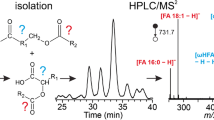Abstract
2-Substituted 4,4-dimethyloxazolines (DMOX) have been found to be a useful alternative to the commonly used methyl esters for the localization of unsaturated bounds and other substituents in the fatty chain by mass spectrometry. The powerful directed fragmentation coupled with good gas chromatographic ability enables the structure elucidation of modified fatty acids in complex mixtures. Continuing our previous study, 76 out of a total of 86 fatty acids obtained from the preen gland wax of shanghai duck now have been identified by gas chromatography-mass spectrometry (GC-MS) of their oxazoline derivatives. The identification was based on the interpretation of the mass spectra and comparison with the spectra and equivalent chain lengths (ECL) of the corresponding methyl esters. Main components of this lipid mixture are straight chain fatty acids (8.22%), and 2-, 4-or 6-monomethyl branched acids (53.69%), amounting to 61.91% of the total acid fraction. In addition, a large number of dimethyl-substituted fatty acids (31.4%) also have been found. Typical mass spectra, which are easily recognizable and highly specific for fatty acids substituted at various positions, are presented and classified according to the structural feature of the chain.
Similar content being viewed by others
Abbreviations
- AMP:
-
2-amino-2-methyl-propanol
- DCC:
-
dicyclohexylcarbodiimide
- DMF-DMA:
-
N,N-dimethyl formamide dimethyl acetal
- DMOX:
-
4,4-dimethyloxazolines
- ECL:
-
equivalent chain lengths
- GC-MS:
-
gas chromatography-mass spectrometry
References
Jacob, J. (1975)J. Chromatogr. Sci. 13, 415–422.
Jacob, J. (1976) inChemistry and Biochemistry of Natural Waxes (Kolattukudy, P.E., ed.) pp. 93–146, Elsevier, Amsterdam.
Stenhagen, E. (1968) inAnalysis and Characterization of Oils, Fats and Fat Products (Boekenoogen, H.A., ed.) pp. 1–44, Vol. 2, Ch. 1, Interscience, New York.
Odham, G., and Stenhagen, E. (1972) inBiochemical Applications of Mass Spectrometry (Wallar, G.R., ed.) pp. 211–228, Wiley-Interscience, New York-London-Sydney-Toronto.
Ryhage, R., and Stenhagen, E. (1960)Arkiv. Kemi 15, 291–315.
Meyerson, S., and Leitch, L.C. (1966)J. Am. Chem. Soc. 88, 56–60.
McCloskey, J.A. (1970) inTopics in Lipid Chemistry (Gunstone, F.D., ed.) Vol. 1, pp. 369–440.
Apon, J.M.B., and Nicolaides, N. (1975)J. Chromatogr. Sci. 13, 467–473.
Nicolaides, N., Apon, J.M.B., and Wang, D.H. (1976)Lipids 16, 279–308.
Nicolaides, N., and Apon, J.M.B. (1977)Biomed. Mass Spectrom. 4, 337–347.
Andersson, B.A. (1978)Progr. Chem. Fats Other Lipids 16, 279–308.
Harvey, D.J. (1982)Biomed. Mass Spectrom. 9, 33–38.
Harvey, D.J. (1984)Biomed. Mas Spectrom. 11, 340–347.
Harvey, D.J., Tiffany, J.M., Duerden, J.M., Pandher, K.S., and Mengher, L.S. (1987)J. Chromatogr. Biomed. Appl. 58, 253–263.
Huang, Z.H., Yu, Q.T., and Zhang, J.Y. (1987)Acta Chim. Sinica 45, 1077–1084; (1988)Acta Chim. Sinica (English edn.) 29–36.
Yu, Q.T., Zhang, J.Y., and Huang, Z.H. (1986)Biomed. Environ. Mass Spectrom. 13, 211–216.
Zhang, J.Y., Yu, Q.T., Liu, B.N., and Huang, Z.H. (1988)Biomed. Environ. Mass Spectrom. 15, 33–44.
Meyers, A.I., and Temple, D.J. (1970)J. Am. Chem. Soc. 92, 6644–6646.
Meyers, A.I., Temple, D.J., Nolen, R.L., and Mihelich, E.D. (1974)J. Org. Chem. 39, 2778–2783.
Svenson, R., and Gronowitz, S. (1982)Chemica Scripta 19, 149–153.
Herslof, M., and Gronowitz, S. (1983)Chemica Scripta 22, 230–235.
Zhang, J.Y., Yu, Q.T., and Huang, Z.H. (1987)Shitzuryo Bunseki (Japan)35, 23–30.
Aasen, A.J., Lauer, W.M., and Holman, R.T. (1970)Lipids 5, 869–877.
Fry, E.M. (1949)J. Org. Chem. 14, 887–894.
Odham, G. (1967)Arkiv. Kemi 27, 289–294.
Odham, G. (1964)Arkiv. Kemi 22, 417–445.
Bertelsen, O., and Nguyen, D.-N. (1982)Chemica Scripta 20, 234–236.
Kolattukudy, P.E., Bohnet, S., and Rogers, L. (1985)J. Lipid Res. 26, 989–994.
Author information
Authors and Affiliations
Additional information
Chemical Modification in Mass Spectrometry 6. For preceding paper in this series, see Ref. 17.
An erratum to this article is available at http://dx.doi.org/10.1007/BF02535256.
About this article
Cite this article
Yu, Q.T., Liu, B.N., Zhang, J.Y. et al. Location of methyl branchings in fatty acids: Fatty acids in uropygial secretion of Shanghai Duck by GC-MS of 4,4-dimethyloxazoline derivatives. Lipids 23, 804–810 (1988). https://doi.org/10.1007/BF02536225
Received:
Accepted:
Issue Date:
DOI: https://doi.org/10.1007/BF02536225




